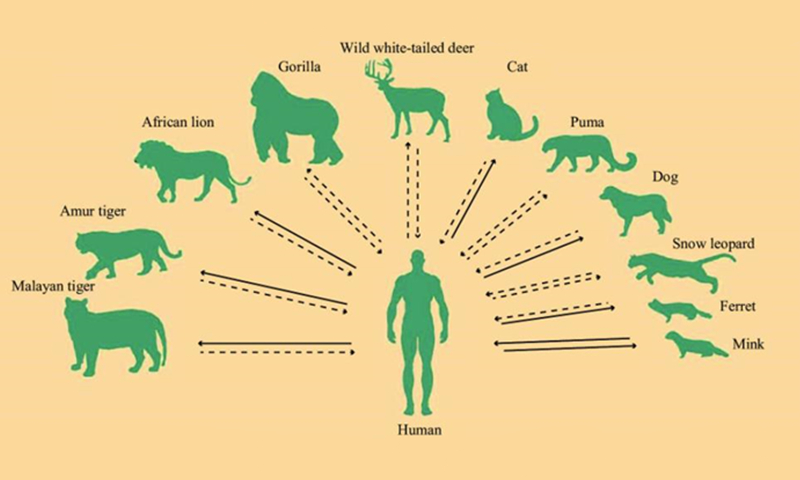Chinese CDC Director: COVID-19 still expanding its host range; necessary for multi-point screening globally

Species that have been reported to be infected by SARS-CoV-2 in nature Photo: China CDC Weekly
The potential for the SARS-CoV-2 to expand into more animal hosts is not over, warned Gao Fu, head of the Chinese Center for Disease Control and Prevention (China CDC), calling for large-scale SARS-CoV-2 screening for global wildlife, especially the most susceptible ones.
This once again proves the complexity of COVID-19 origins and transmissions and the absurdity of the "COVID-19 came from China" notion, said Chinese virologists and epidemiologists reached by the Global Times on Sunday. They noted the necessity of conducting origins-tracing work in multiple places across the world.
Several types of mammals could be a reservoir for SARS-CoV-2 apart from humans which could lead to spillback to humans, according to the article published on English-language website China CDC Weekly on Friday, of which Gao was one of the authors.
It said that natural infection of SARS-CoV-2 has been found in several species of mammals via contact with COVID-19 patients, such as cats and dogs, or lions and tigers in zoos, minks and ferrets.
In nature, snow leopards, pumas and gorillas also have been found to be infected with SARS-CoV-2, it added.
The article cites serosurveillance by the US Department of Agriculture in early 2021, with results published in July, that showed that antibodies against SARS-CoV-2 were found in 40 percent of 600 samples of wild white-tailed deer (Odocoileus virginianus) from the US in 2021.
By contrast, antibodies were detected in only one and three white-tailed deer samples from 2019 and 2020, respectively.
"Due to the wide geographic distribution and large population (approximately 30 million) of wild white-tailed deer in North America, it increased the risk that SARS-CoV-2 from wildlife would spillback to humans," the article said.
The expansion of SARS-CoV-2 in the wild would lead to other animals being infected with SARS-CoV-2 via direct or indirect contact with wild white-tailed deer or even infected patients, according to the article.
Experimental studies have demonstrated several animals could be susceptible to SARS-CoV-2, such as Egyptian fruit bats (Rousettus aegyptiacus) and North American deer mice (Peromyscus maniculatus), it said.
"However, these are just the tip of the iceberg," it said, noting susceptibility of most terrestrial wild animals to SARS-CoV-2 "has not been tested."
So far, the mysteries of the route through which SARS-CoV-2-related coronaviruses were transmitted from bats to humans and if bats were the original reservoir "still remain unsolved," it said.
Various studies conducted by scientists worldwide have shown that COVID-19, though firstly reported in Central China's Wuhan city at the end of 2019, had earlier shown up in places across the world, virologists pointed out.
It is impossible that in the early stages COVID-19 appeared only in China, said Yang Zhanqiu, a virologist from Wuhan University. "The virus was highly likely to have emerged in other places, but was not tested," Yang told the Global Times.
Global scientists have proved that COVID-19 was unlikely leaked from a Chinese lab, refuting the lab-leak conspiracy theory that some US politicians utilize to politicalize the pandemic and smear China.
In an article included by SienceDirect, a bibliographic database of scientific and medical publications, French researchers proved the irrelevance between SARS-CoV-2 and RaTG13, a virus that was collected in a mine in Mojiang, Southwest China's Yunnan Province.
"SARS-CoV-2 does not originate from the Mojiang mine," the article said, refuting an argument put forward by two Indian scientists that the virus came from Mojiang. "The Mojiang mine theory is not valid."
COVID-19 may have been silently spreading in the US as early as September 2019, suggested a research paper released last month on ChinaXiv, a preprint platform developed by the Chinese Academy of Sciences (CAS), authored by researchers from the University of Science and Technology of China and the University of Chinese Academy of Sciences.
The multi-point outbreaks of COVID-19 prove that carrying out origins-tracing work globally is essential and scientific, Yang noted, appealing to the WHO to conduct related investigations in areas with early transmissions including the US and Europe.
Gao also mentioned in his report the current shortage of the research on susceptibility of marine wildlife, especially marine mammals to SARS-CoV-2.
"Worse, SARS-CoV-2 might spread in the marine ecosystem, which may lead to the generation of some novel SARS-CoV-2 variants with unknown threats to humans," it warned.
Taking the continuing expansion of SARS-CoV-2 into account, the article emphasized it is necessary to carry out large-scale screening of terrestrial and marine wildlife, to monitor the status of infection and mutation of virus in wild animals, "so as to formulate further prevention and control strategies."



